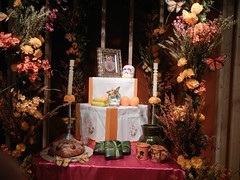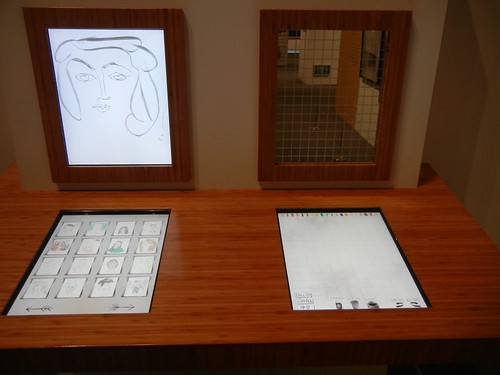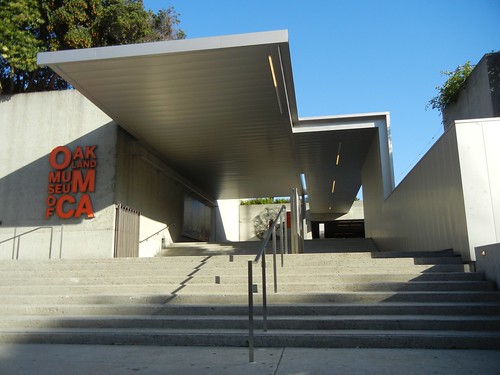 Today I managed a first, too-short visit to the Oakland Museum of California, a science, art and history museum dedicated to "telling the story of California." It was a quiet Wednesday afternoon, so I had much of the museum to myself, which was really nice for a first visit.
Today I managed a first, too-short visit to the Oakland Museum of California, a science, art and history museum dedicated to "telling the story of California." It was a quiet Wednesday afternoon, so I had much of the museum to myself, which was really nice for a first visit.
The museum is divided into 3 section on art, history and nature / science. The science section is actually scheduled to open up in the Spring of 2012. But in the interim there is a great exhibit about the naturalist John Muir being shown that had a strong science and environmental focus.
Here's a little recap of my first visit to the Oakland Museum of California..
Arts Collections
I really enjoyed strolling through the arts colections of the museum, which focused on California as the subject of artwork and all of the many, many artists that have come from California. There's a lot of see, in a variety of genres, formats and media, from classic landscapes from the 1800s to multimedia, interactive displays from contemporary artists.
 Since it is October, there was a large "Dia de Los Muertos" exhibit, with several ofrendas or altars created by local artists to remember lost loved ones. Dia de los Muertos has always been one of my favorite holidays, with the garish skeleton and skull motifs, colorful displays and streamers, and feasts to remember the dead.
Since it is October, there was a large "Dia de Los Muertos" exhibit, with several ofrendas or altars created by local artists to remember lost loved ones. Dia de los Muertos has always been one of my favorite holidays, with the garish skeleton and skull motifs, colorful displays and streamers, and feasts to remember the dead.
Only recently I discovered that Dia de los Muertos is also commemorated in my native Philippines. My mother tells me that as a child she would go with her family to the cemetery on November 1 to have a picnic near the graves of their deceased family members. She remembers trying to spot celebrities who were visiting their deceased relatives and the food and fun of the day.
By the way, this Saturday, October 23, the museum is holding a day-long community celebration of the Day of the Dead, including crafting, food, music and dance. Looks fantastic. But I digress.
I appreciated how the museum interspersed interactive media kiosks and displays throughout the galleries, to increase engagement with visitors. For example, in the art gallery there is a whole section on the faces of California. Next to a wall of portraits, there is an interactive kiosk where the visitor can draw her or his own face on a touch screen, using various colored "brushes," and then share it with others and email the picture to yourself.
 Here's my own beautiful work of art I created, for example, to the right. I know, impressive. 😉
Here's my own beautiful work of art I created, for example, to the right. I know, impressive. 😉
Not all of the interactive displays were high tech. One of my favorites was a simple stereoscope, with about 20 different sets of historical photos. Other sections asked the visitor relevant questions ("What is art?") and let them write their answers on notes posted to a large bulletin board.
Another interactive kiosk (which I suspect was a Microsoft "Surface" display) allowed the visitor to zoom around an interactive map of different folk art spots in the state on a giant table-mounted touch screen. Playing around with it gave me lots of ideas of where I wanted to travel to next in the state. I do wish it had a function where I could email myself notes about those locales.
History Collections
Next I headed to the history section of the museum. Organized chronologically, the visitor starts with the earliest human inhabitants of California, the different Native American tribes, and walks forward in history to the present.
A lot of effort is made to make the history of California come alive for the visitor. I appreciated how much the curators focused on the stories of individuals throughout history, from famous figures to everyday folks like an African-American miner, a Chinese railroad worker, or a Japanese field worker. You get a strong sense of how multi-cultural California has always been, as an entry point for immigrants from all over the world seeking a better life.
In the section during WWII, I had to stop and play with the jukebox loaded up with lots of great swing tunes. And who can listen to swing music? You have to dance!
There's a whole section on how California became the center of the entertainment industry in America. Amidst all the memorability from the film industry, there are a couple of neat interactive exhibits on animation and sound effects that was similar to other exhibits I've seen at the Zeum in San Francisco and the Museum of the Moving Image in New York.
And there's a lot more I saw that I don't have time to write about…
I recommend at least an afternoon for someone to get to experience the full museum in any comprehensive way. And once the science section is open, I'm sure there will easily be a full day of things to see for the die-hard museum-goer. I can't wait to come back!
A New / Old Institution?
So all of this has made me wonder about the history and visibility of the museum, which dates from 1969. Why have I never heard of the museum, or have none of my friends? Why didn't I come here as a child? In my opinion, the Oakland Museum is in a class up there with the Cal Academy of Science and the Exploratorium in terms of diversity and quality of their collections and number of engaging exhibits and activities. Lots of Yelp reviews extoll the praises of the museum, so I know I'm not alone.
It might be this that incarnation of the museum is still relatively new, with major renovations only completed around May 2010, and their science wing still being worked on. It sounds like they might need some more public-facing programs that highlight the strengths of the museum for their different audiences. Events like their "Dia De Los Muertos" festival seem like one way to bring in the larger community. I would love to talk to their marketing and social media folks about how they are spreading the word about the institition. I've got a few things to share in that area, of course.
The Oakland Museum of California is located at the corner of Oak and 10th Street in downtown Oakland. See the website for hours, admission, exhibits and special events info.


